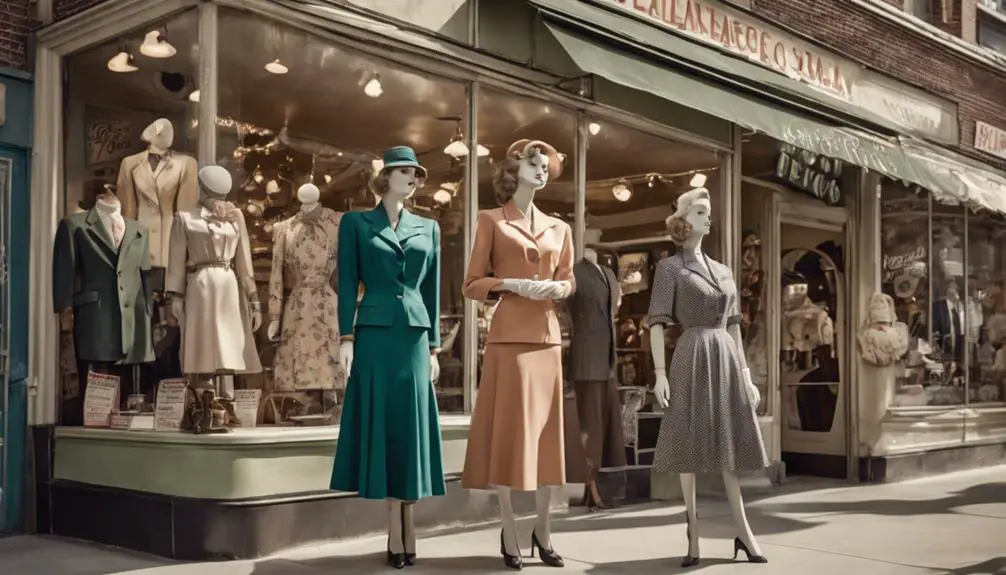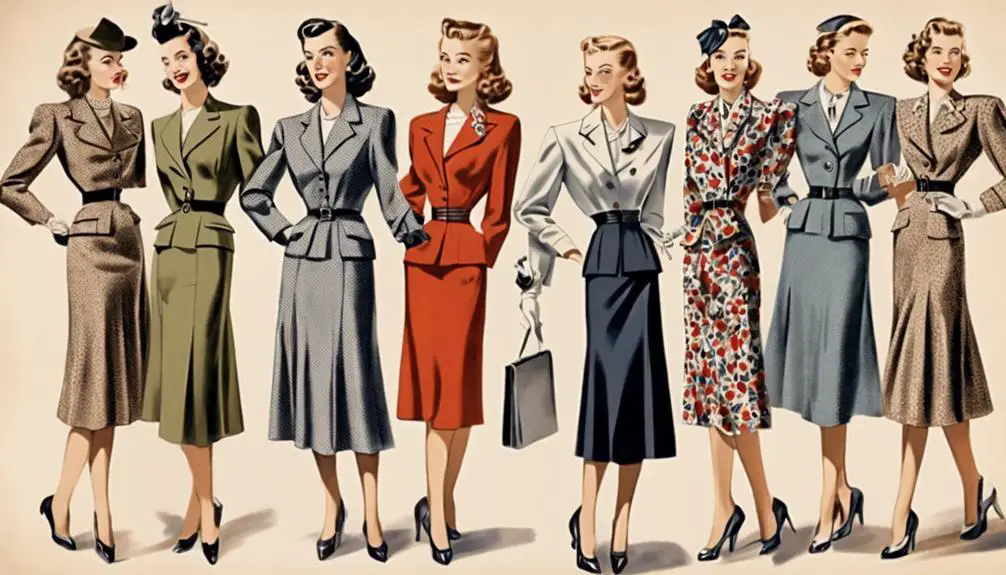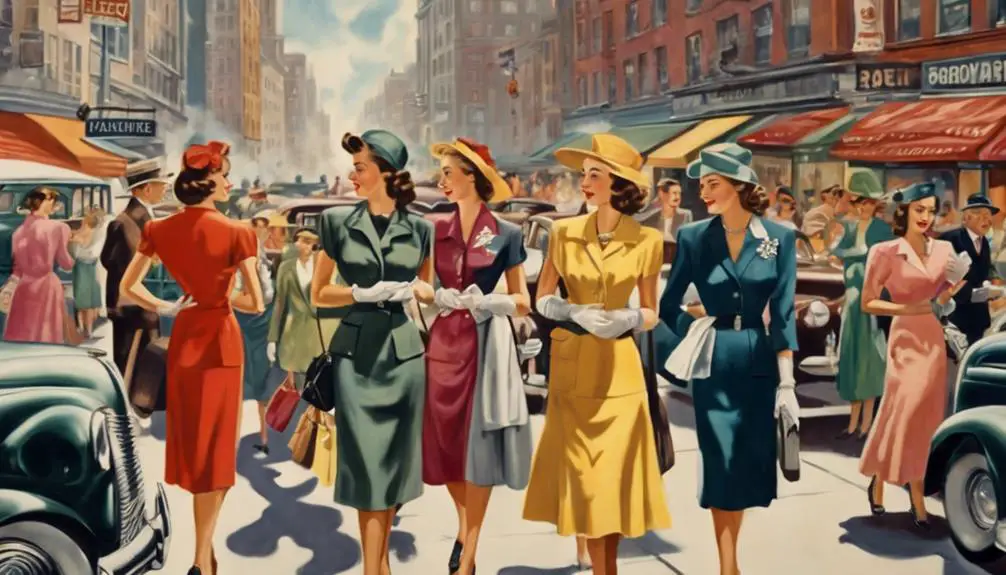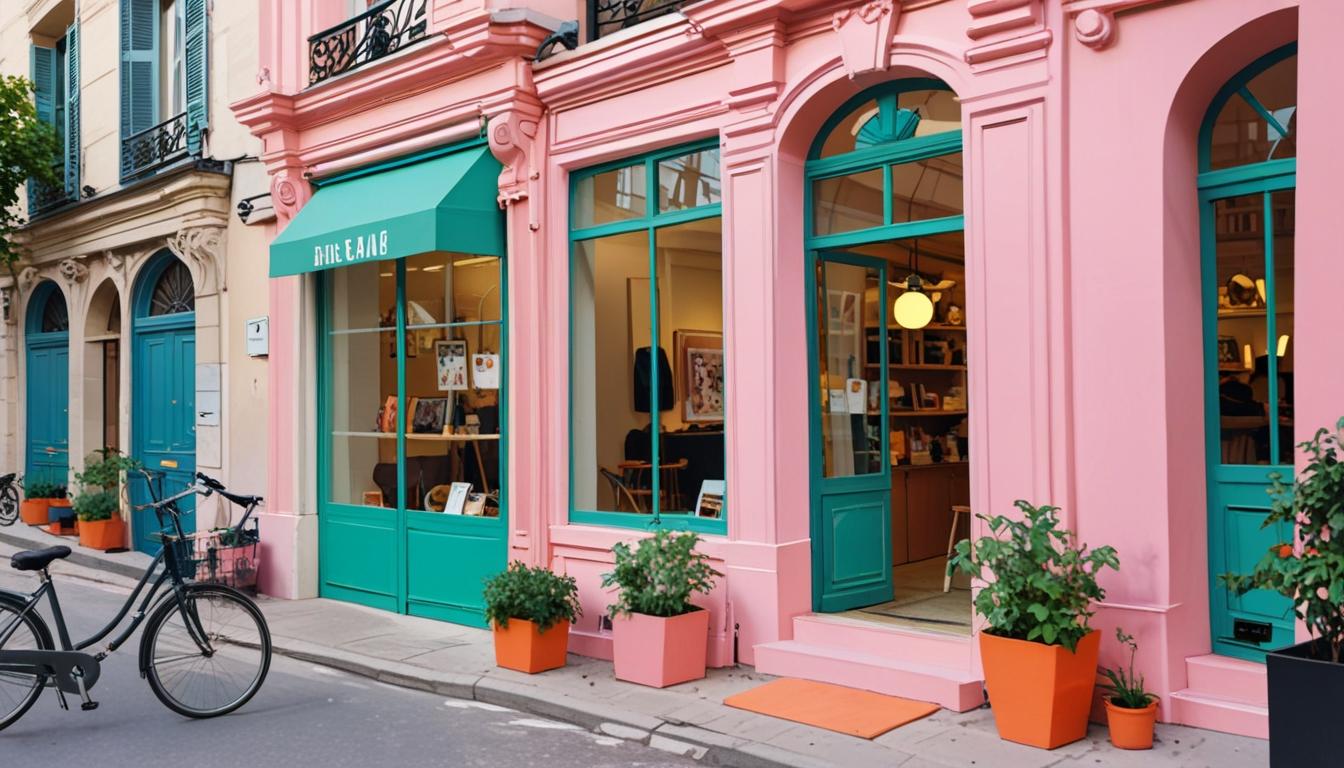In the mid-1940s, several fashion brands rose to prominence, reflecting the era's blend of utility and glamour. Christian Dior's "New Look" transformed women's fashion in 1947 with its cinched waists and full skirts, symbolizing a return to femininity. American designers like Claire McCardell introduced comfortable styles that appealed to everyday life. In Britain, Norman Hartnell crafted elegant, wartime-appropriate clothing, while Paris saw Coco Chanel reintroducing her timeless suits. These brands navigated societal changes, showcasing resilience and creativity. Want to learn more about the fascinating shifts in fashion during this exciting period? You'll be intrigued by what comes next!
Historical Overview of Fashion Brands

The evolution of fashion brands in the mid-1940s reflects a remarkable blend of resilience and creativity. During this time, the fashion landscape transformed dramatically, adapting to the constraints of wartime austerity while also paving the way for a vibrant postwar culture.
Christian Dior's introduction of the "New Look" in 1947 was a game-changer, revolutionizing women's clothing with its signature cinched waists and voluminous skirts. This bold move established Dior as a leader in haute couture, signaling a shift from the utilitarian styles of the previous years. Additionally, the impact of American designers like Ralph Lauren, who'd later gain prominence in the 1960s and beyond, laid the groundwork for a merging of luxury and casual styles that would define future fashion trends identifying vintage Ralph Lauren.
British clothing manufacturers played an essential role in this period, creating garments under the Utility Clothing Scheme. They focused on practicality and resourcefulness, emphasizing designs that adhered to government regulations on fabric use. While these styles were born from necessity, they laid the groundwork for future innovation in fashion.
As the postwar years unfolded, swimwear brands began to emerge, tapping into the growing leisure culture and beach lifestyle. Their playful designs reflected a newfound sense of freedom and fun. Accessories also gained traction, with hats and gloves becoming essential components of women's outfits. These items elevated everyday clothing, enhancing the overall aesthetic of the time.
In essence, the mid-1940s was a pivotal moment for fashion brands, balancing the remnants of wartime austerity with fresh creativity. The interplay of utility and haute couture set the stage for the vibrant fashion world that we understand today.
Iconic American Fashion Labels
Fashion in the mid-1940s marked a significant turning point, especially in American labels that began to shape the industry. The era saw innovative designers who transformed women's fashion with their unique visions. One of the most influential moments was when Christian Dior introduced his "New Look" in 1947. This style emphasized a feminine silhouette, featuring voluminous skirts and nipped-in waists, which quickly inspired American designers to adopt similar aesthetics.
Particularly, Calvin Klein, who'd later revolutionize American fashion in the 1970s and beyond, helped to redefine casual wear and branding, showcasing a commitment to modern trends and inclusivity in his future collections, particularly with the launch of Calvin Klein Jeans in 1978.
Amidst the constraints of fabric rationing, American designers still found ways to shine. Norman Norell became renowned for his luxurious evening wear, using sequins to add glamour, even during tough times. This innovation allowed women to feel elegant and sophisticated despite the challenges of wartime.
In the domain of sportswear, Claire McCardell revolutionized women's fashion with her practical styles. Her Popover dress became a staple, focusing on comfort and versatility, perfectly suited for the active lifestyle of the time.
Meanwhile, Hattie Carnegie created tailored suits that blended high fashion with practicality, catering to working women who needed stylish yet functional clothing.
Brands like Levi Strauss & Co. also made their mark during this period, introducing iconic denim styles like classic blue jeans, which would become a staple in American wardrobes.
These labels and their contributions not only reflected the changing times but also laid the groundwork for future American fashion, blending elegance with practicality in a way that resonated with women across the nation.
Influential British Fashion Designers

During the 1940s, British fashion emerged as a beacon of creativity and resilience, showcasing designers who skillfully navigated wartime restrictions while maintaining elegance. Designers like Norman Hartnell and Edward Molyneux played pivotal roles in defining this era, ensuring that style persisted despite fabric rationing.
The evolution of fashion was also influenced by iconic brands such as Burberry, which adapted its designs and materials during this time to meet the changing needs of consumers and the marketplace, reflecting its rich history and evolution.
- Hartnell was appointed Royal Warrant by the Queen Mother in 1940.
- Molyneux crafted utility clothing that combined flair with function.
- Hardy Amies gained recognition for his tailored suits designed for working women.
- The Incorporated Society of London standardized utility clothing, blending practicality with fashion.
Norman Hartnell dazzled with his elegant evening wear and was later tasked with designing Queen Elizabeth II's wedding dress in 1947, cementing his place in British fashion history.
Edward Molyneux, on the other hand, focused on creating utility suits that adhered to wartime restrictions while ensuring women maintained a sense of style, featuring nipped-in waists and padded shoulders.
Hardy Amies also made waves, offering tailored suits that merged sophistication with the practical needs of working women.
Through the efforts of these fashion designers, British fashion thrived, proving that creativity could flourish even in the toughest of times. The impact of their work not only shaped the wardrobe of the 1940s but also laid the foundation for future generations of designers, inspiring an enduring legacy in the world of fashion.
Notable French Fashion Houses
Post-war fashion saw French houses stepping into the spotlight, revolutionizing women's attire with innovative designs. One of the most notable names during this time was Christian Dior. He launched his fashion house in 1946 and quickly gained fame with his "New Look" collection in 1947. This collection featured nipped-in waists and voluminous skirts, reshaping women's fashion after WWII.
Similar to how Versace's logo evolution reflects a distinct era, Dior's designs marked a significant shift in women's silhouettes.
Coco Chanel remained a significant force in the 1940s, known for her timeless designs. She reintroduced the classic Chanel suit, which emphasized elegance and simplicity, making it a staple in women's wardrobes.
Meanwhile, Jeanne Lanvin, a leading French designer, was celebrated for her feminine silhouettes and use of luxury fabrics, leaving a lasting influence throughout the decade.
Elsa Schiaparelli's designs took a daring approach. Known for her avant-garde and surrealist styles, she often used bold colors and unconventional patterns to challenge traditional fashion norms. This creativity made her a standout in the fashion scene.
Another key player, Pierre Balmain, founded his fashion house in 1945. He quickly gained recognition for his luxurious, sophisticated designs, appealing to the elite and helping to revive haute couture in the post-war era.
Together, these fashion houses and designers not only defined the mid-1940s style but also paved the way for the future of women's fashion, emphasizing luxury and creativity. Their contributions continue to inspire designers today, proving the lasting impact of their innovative spirit.
Impact of Fashion on Society

Clothes aren't just items we wear; they reflect and shape societal values and norms. In the mid-1940s, fashion was profoundly influenced by World War II and the subsequent cultural shifts. As women stepped into roles previously held by men, fashion evolved to embrace practicality while also celebrating femininity.
- Utility garments emerged, emphasizing resourcefulness during wartime clothing restrictions.
- Christian Dior's New Look in 1947 redefined femininity and luxury, contrasting with the austere styles that dominated during the war.
- Fashion icons like Katharine Hepburn and Ava Gardner championed tailored trousers, showcasing a new sense of empowerment.
- London Fashion Designers began to craft styles that balanced function and flair, reflecting the changing societal norms.
The introduction of utility clothing in the UK highlighted a need for practicality, while American designers like Claire McCardell created comfortable, innovative designs that influenced everyday wear.
After the war, Dior's New Look marked a cultural shift, promoting a more glamorous image of women. This change in women's dress not only reshaped fashion but also societal expectations, encouraging women to embrace their femininity after years of functional attire.




